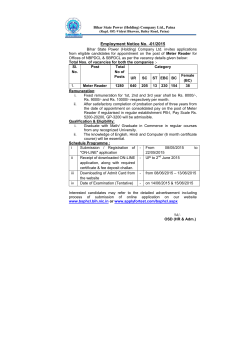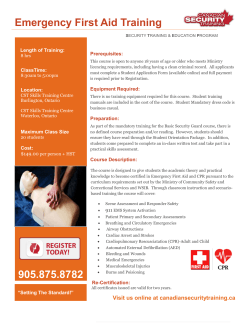
Calibration, Fluid Property Effects Reproducibility and Long Term
Calibration, Fluid Property Effects Reproducibility and Long Term Stability. All in 20 minutes! Dr Gregor Brown Cameron Agenda • Calibration process • Cameron calibration laboratory • Reproducibility/calibration transfer to other fluids • Meter design and impact on the influence of fluid properties • Calibration transfer to the field • Long term stability 4-path, 8-path and 8-path RN meters Linearity +/- 0.1% Linearity +/- 0.1 % Linearity +/- 0.15 % Calibration process for Caldon meters • Characterise over the Reynolds range of the application, using one, two or three oils • Enter calibration data into two tables in the meter as a function of measured profile flatness and/or Reynolds number • Calibrate the linearized meter using each of the oils; default six flowrates per oil to API 5.8 repeatability requirements Raw Calibration vs Flow Rate 1.0 Gas oil at 20 deg C Kerosene at 20 deg C Meter Factor 1.0 1.0 1.0 1.0 0 100 200 300 400 Flow Rate (m3/hr) 500 600 700 800 Reynolds Number Calibration Curve 1.0 Meter Factor 1.0 Gas oil at 20 deg C Kerosene at 20 deg C MF curve used 1.0 1.0 1.0 10,000 100,000 Reynolds Number 1,000,000 Final Calibration Result 0.60 Gas Oil 0.45 Kerosene 0.30 Error (%) 0.15 0.00 -0.15 -0.30 -0.45 -0.60 0 100 200 300 400 Flowrate (m3/hr) 500 600 700 800 CALDON ULTRASONICS TECHNOLOGY CENTRE CALIBRATION LABORATORY PITTSBURGH, USA Main laboratory area • • • • • • Prover Master meters Heat exchanger Test meter lines 7.5 ton bridge crane Main control room Calibration fluids • Refined hydrocarbon oils • Oils chosen to give a good range of viscosity for Reynolds number span – EXXSOL D80, kerosene substitute, approx. 3 cSt – DRAKEOL 5, approx. 15 cSt – DRAKEOL 32, approx. 150 cSt NVLAP Certified Uncertainties • 10 to 750 m3/hr – Small volume prover 0.03% – Turbine master meter 0.04% • 150 to 2200 m3/hr – Ball prover 10 m3 0.04% – Ball prover 3.3 m3 0.07% – One master meter 0.09% • 600 to 3900 m3/hr – Two master meters 0.08% Comparison of ISO17025 capabilities ISO 17025 Accredited Laboratory Uncertainties 0.25 Cameron CUTC 0.20 TUV NEL TRAPIL SPSE 0.15 Uncertainty (%) 0.10 0.05 0.00 -0.05 -0.10 -0.15 -0.20 -0.25 0 500 1,000 1,500 2,000 Flow rate (m3/hr) 2,500 3,000 3,500 4,000 Mutual recognition arrangements • NVLAP is a signatory to the following MRA’s: – ILAC - International Laboratory Accreditation Cooperation – APLAC - Asia Pacific Laboratory Accreditation Cooperation – IAAC - Inter American Accreditation Cooperation VSL CMC Certification • The National Measurement Institute of the Netherlands, VSL, provide Cameron with an additional Calibration Measurement Capabilities (CMC) certification • This certification focuses on the uncertainty of the calibration method • This is a voluntary certification that adds a further layer of quality assurance to the Caldon laboratory operations Intercomparision using 8-path USMs Caldon NEL, UK Intercomparision package • Primary comparison was carried out using kerosene substitute (Exxsol D80) over a flow range of 100 to 600 m3/hr in both facilities – Caldon lab tests vs ball prover – NEL tests versus turbine secondary standards • A secondary comparison was also carried out using the NEL water flow facility gravimetric standard • Comparisons were made at overlapping Reynolds numbers Intercomparision results on kerosene 0.15% Meter 1 Meter 2 Combined uncertainty acceptance limits 0.10% Difference (%) 0.05% 0.00% -0.05% -0.10% -0.15% 4.9 5.0 5.1 5.2 5.3 5.4 Log Reynolds number 5.5 5.6 5.7 Intercomparision results vs water 0.15% 0.10% NEL oil data compared to Cameron oil calibration NEL Water data compared to Cameron oil calibration Combined uncertainty acceptance limits Difference (%) 0.05% 0.00% -0.05% -0.10% -0.15% 4.9 5.0 5.1 5.2 5.3 5.4 Log Reynolds number 5.5 5.6 5.7 Intercomparision results • The results from both meters and both NEL facilities (oil and water) demonstrated metrological equivalence with the Caldon laboratory • The closest and most linear agreement was actually found in the case of the water comparison, suggesting that the difference in the oil calibration were in part due to the curve fitting to the NEL secondary standard turbines Influence of inputs and design on fluid property effects Internal linearization • The more linear the meter is to start with the less correction is required • Correction using velocity profile may be prone to installation effects, which can have a Reynolds dependence • Correction using an inferred Reynolds number requires a reliable viscosity input • Good design can minimize residual fluid property effects Linearity before adjustment of two 6-inch meters • Both 8-path meters, same electronics, same transducers • Intentional meter body design differences 0.994 Meter factor (before any correction) 0.992 0.990 0.988 0.986 0.984 0.982 Meter design variant A Meter design variant B 0.980 0.978 0 50,000 100,000 150,000 200,000 250,000 300,000 350,000 400,000 450,000 500,000 Reynolds number 0.994 Meter factor (before any correction) 0.992 Large viscosity input error 0.990 Variant A – 0.05% MF change 0.988 Variant B – 0.22% MF change 0.986 0.984 0.982 Meter design variant A Meter design variant B 0.980 0.978 0 50,000 100,000 150,000 200,000 250,000 300,000 350,000 400,000 450,000 500,000 Reynolds number Design variants can minimise non-linearity and installation effects This can involve some differences in design/model selection and configuration for different applications 10-inch full-bore LNG meters for high Re 11 LNG meters after single point MF adjustment 1.0020 10-inch Caldon LEFM 280C 1.0016 1.0012 Meter factor 1.0008 +/-0.08% 1.0004 1.0000 0.9996 0.9992 0.9988 0.9984 0.9980 200 400 600 800 1000 1200 1400 Flow rate (m3/hr) 1600 1800 2000 2200 Reducing Nozzle Meter for Low Reynolds Numbers 10-inch LEFM 280CiRN test • Three installation configurations tested without adjustment of the meter between tests • 10-inch meter vs 10 m3 unidirectional prover • Two fluids/viscosities (12 and 100 cSt) • 6 flow rates for each condition, mean value at each flow determined to better than +/- 0.027% Installation at 5D Installation at 5D with added swirl Installation with 10D – CPA – 10D Linearity/error data vs flowrate – 12 cSt oil 1.0% 5D, 12 cSt 5D added swirl, 12 cSt 10D - CPA - 10D, 12 cSt 0.8% 0.6% 0.4% Error (%) 0.2% 0.0% -0.2% -0.4% Three pipe configurations -0.6% Linearity +/-0.05 % -0.8% Turndown 15:1 -1.0% 0 200 400 600 800 1,000 Flowrate (m3/hr) 1,200 1,400 1,600 Linearity/error data vs flowrate – 100 cSt oil 1.0% 5D, 100 cSt 0.8% 5D added swirl, 100 cSt 0.6% 10D - CPA - 10D, 100 cSt 0.4% Error (%) 0.2% 0.0% -0.2% -0.4% Three pipe configurations -0.6% Linearity +/-0.055 % -0.8% Turndown 15:1 -1.0% 0 200 400 600 800 1,000 Flowrate (m3/hr) 1,200 1,400 1,600 Linearity data vs Reynolds number 1.0% 0.8% 5D, 99 cSt 5D added swirl, 99 cSt 10D - CPA - 10D, 99 cSt 0.6% 5D, 12 cSt 5D added swirl, 12 cSt 10D - CPA - 10D, 12 cSt 0.4% Error (%) 0.2% 0.0% -0.2% -0.4% Three pipe configurations -0.6% Linearity +/-0.055 % -0.8% Turndown 124:1 (Re) -1.0% 1,000 10,000 100,000 Reynolds number 1,000,000 8-Path Full-Bore Configuration No flow conditioner and 5D Toledo refinery, full bore 8-path meter Toledo refinery proving reports API 64 MF 1.00121 API 35.5 API 42.5 MF 1.00110 MF 1.00098 UK Chevron Alba FSU Export Metering • Original system based on positive displacement (PD) meters and a ball prover was first replaced by a clamp-on meter based system on the export line • Due to poor performance an upgrade was required • Aim was to install with minimum changes to the original installation • High viscosity (100 cSt) and limited space for installation as PD meters are not sensitive to installation effects • Two 16-inch Caldon 8-path 280Ci flowmeters installed • Traceable to Cameron’s ISO17025 calibration lab • Commissioned in 2011 Original system with PD meters (Chevron Presentation at NEL/DECC oil and gas focus group meeting 2014) Long Term Stability Calibration laboratory 10-inch Master Meters • 8-path master meters are calibrated before use • Control charts used to ensure everything is working as it should be Unlinearised MF vs Re: 7 years of data Reynolds Number Control Chart 10 inch 280C MM1 1.006 1.004 1.002 Meter Factor 1.000 0.998 0.996 0.994 0.992 0.990 0.988 0.986 1,000 10,000 100,000 Reynolds Number 1,000,000 10,000,000 Summary • Good quality ultrasonic meters are essentially stable and affected mainly by fluid hydraulics – Due to time limitations today I have not covered viscous attenuation and turndown effects • Achieving and maintaining good linearity and reproducibility of meter factor is not straight forward but can be achieved with due care and attention at each stage of design and selection, calibration and implementation
© Copyright 2025









